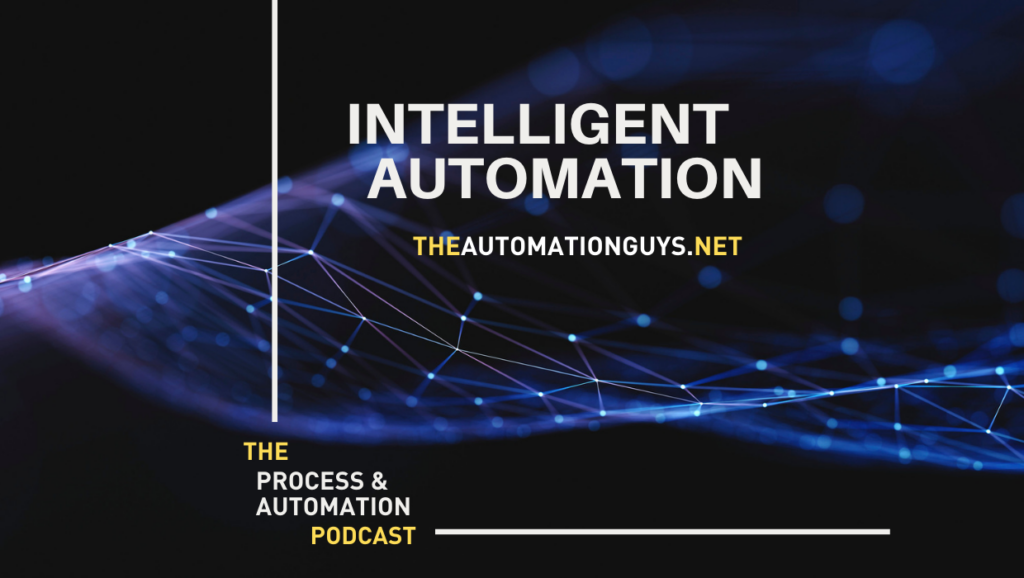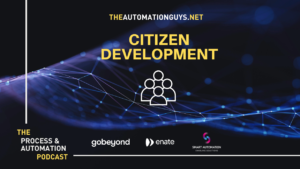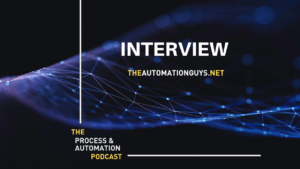Blog

Demystifying Hyperautomation PART 1
In this episode of the podcast we talk about the new buzz word Hyperautomation and will go through what Hyperautomation is, Technologies, Benefits, Challenges.
Share This Post
This is our opportunity to talk about the latest in process and automation, low-code, workflow, RPA, AI, chatbots and about building the right team for automation success.
Do you have any questions? Would you like to give us feedback? Are you interested in workshops on the topic of automation? Are you an expert in the field of automation and would like to be on the podcast?
Just get in touch:
LinkedIn Arno: https://bit.ly/3aABArd
LinkedIn Sascha: https://bit.ly/36Jd31T
Velocity-IT: https://www.velocity-it.com/about-us/
convedo Group: https://www.convedo.com/about-us
Episode Transcript
[00:00:00] Hello and welcome to another episode of the Process in Automation podcast with the automation guys.
[00:00:16] Today’s podcast is all about automation, you’re going to demystify hyperautomation, bit by bit.
[00:00:24] We get a good understanding of what technologies are within hyper automation, what it is, what you can do with it, what you actually get out of it from a business perspective.
So Arno, What do you think? What is this hype automation or is everyone going crazy on on this new buzzword?
[00:00:49] I think there is actually quite a lot of confusion when people talk about the term hyperautomation out there. I think if you ask 10 different professionals what they think it means, even if they have some subject knowledge, you would probably get 10 different answers.
You know, for me, I guess automation can be something which people view, you know, in context of the things they’ve read about it, maybe what they’ve heard their colleagues talk about, maybe what they’ve seen or what the analysts are talking about.
But in essence, for me, hyper automation is getting automation into your business at a very, very rapid pace. So from ideation, where we look at a problem to actually execution and production production ideation of that, and that should be something that should be very fast.
And in order to achieve that, that’s where you would utilise or even exploit some of the progressive automation technologies. And those include what I would considered the three pillars of high tech hyper automation myself, which is artificial intelligence.
And that’s obviously a big topic on its own. But it’s basically having a neural network that could make cognitive decisions on behalf of a user or react on a user’s input and provide some guidance as to, you know, what decisions should be made and make recommendations.
So I say it’s quite a big thing. It’s got a big buzzword at the minute. I very easily accessible. It’s very commodity.
So you could have as much as you need by doing subscriptions or you could build your own models. So that’s quite a big, big topic in itself. And I think that will only grow in the next couple of years.
And also the concept of process mining a process mining is actually a way that you could look inside your business and discover things that is broken so you could discover processes that’s broken by looking by by looking at these at your systems and that the process, mining software will will sort of kind of steer you in a direction to to tell you.
Well, you know, I think this this process here, it’s taking very long. And, you know, that’s a good candidate to do a bit of investigation.
Then I guess the third pillar is what we call what we call a robotic process, automation, and that’s that’s literally training a piece of software to behave like a human and teaching it to click on applications and teaching it to log on to different systems and do stuff like a human would do that, but obviously very accurate and up to 20, 30 times faster than a human.
So I think if you if you combine all of those things together, find the right problems to solve because the technology is out there, all you need to do is find those problems, apply those technologies rapidly. Then you are officially on your hyperautomation journey and you could stretch that up as long as you want to, because the benefits that it will start to provide, you would obviously unlock more of your staff’s time.
They can contribute more towards your hyper automation programme and you can have more initiatives. I mean, what’s your view, Sachar?
[00:04:52] I think then the big the big difference to the other automation topic. So obviously automation is out there for a long time. So automation is now really, I think, putting all these things together to to really achieve this end to end kind of processing much better than just these individual things we we looked at before.
So now when you think about the process automation, an invoice comes in, so first of all, you need to OCR it. So this was in the past, maybe just OCR and then someone did something with it, but now with all the disciplines of automation of what we classify as automation these days, we can truly achieve end to end processing in the organisation.
So really going from modern systems into legacy systems, though, there’s no barrier anymore with ARPA for us.
So I think you’re combining all these things together. That really is the game changer for for lots of businesses.
We we had lots of success just with workflow, just with A.I. but now combining all these things together and then using, for example, process mining to actually figure out that you have made it all better for the business is quite fascinating. And what do you think?
I know sort of the best use cases, so it just mentioned scanning OCR. Now, did you have any sort of particular use cases businesses would use hyper automation for?
[00:06:41] I think every business can potentially benefit from it. I think hyper automation is as sort of a culture, a cultural thing within sight of business. It’s a way, way to think about how you run your business.
I think there’s this this there’s no there’s no one size fits all for this. It can be as small as it needs to be on day one. What could be really large and very transformational towards that is the maturity off of your hyperautomation and, you know, life cycle.
In terms of use cases, you know, I think if you look at businesses, you know where you need to connect and journey together.
If you look at finance, for instance, there’s a lot of there’s a lot of processes within site finance. If you take your invoice example, where it’s, you know, accounts payable, you would typically, you know, the process that precedes that is going to be supplier onboarding.
It’s a supplier onboarding. It’s going to be a lot of things in there that’s perhaps manual way onboard a supplier, there might be some contractual things you need to do and some legal due diligence you need to do, and so it is a bit like, you know, when when you look at one particular area within finance, it’s so connected with other things that that is, you know, other dependencies that you need to really choose, you know, how much do I want to bite off initially and how ready is my business to to start embracing this now, again, for the finance example, it could be as simple as, you know, you’ve got a sharing box and everybody has seen the sharing boxes across the business where, you know, suppliers, emails, invoices go into. A typical scenario would be that somebody looks at the invoice., they recognise that this needs to be approved then they send it to that particular person for approval based on the invoice amount. They need to make sure that the customer account and all the invoice details are all correct. So there’s a lot of things in there that need manual checking. So I think that’s a perfect example of where you could plug a tiny bit of automation in. I wouldn’t call it hyperautomation at that point, but I think as you as you start evolving that process and rather than somebody looking at that inbox, perhaps you train a robot to monitor the inbox to listen out for invoices, when that invoice is received, you could then send that to another robot that does the OCR of the invoice. You know, once you’ve got the OCR back, perhaps you could have an artificial intelligence model that makes sure that the unstructured data, because of course, every invoice looks different for every supplier. But you could deploy a bit of artificial intelligence to extract that structured data from unstructured document and then pass that, you know, along the next step of the process where another robot might decide, does this need to go to a human for review? or is it below the threshold? Can I just automatically approve this and submit that to accounts payable.
[00:10:37] Yeah, you mentioned that unstructured data. I think that was for many. I think when when people started with ARPA, we were not talking about A.I. back then and and other things. So that unstructured data was really a big, big problem because they could do all these things, but only if they understand the data. So if the data is already then a good structure, then the bots can really do good stuff. But, you know, what are you doing with the with these invoices? They all always contracts. By nature, they all unstructured and then quite useless to a bot in itself. So that was very important. So when OCR came back. Right. A couple of years ago to become very, very sexy again. Yes. Really. Really.
[00:11:25] Yeah. And I guess intelligent OCR. Yeah, exactly. I think if you if you look at if you look at what RPI vendors do and you know, the sort of things that I guess is in their roadmap, you’ll see a lot of them are actually investing in artificial intelligence because they know that that’s the next step. The next step is to take robotic sequences where you train a robot software bot to do stuff and and and really enhance that by giving it some cognitive behaviour so it can actually understand the difference between, you know, a O and zero on an invoice and make a decision to say, well, this was OCR wrong. This is definitely Azera. It’s not a no. You can make that decision. And and the process doesn’t break down there where, you know, you’ve got a piece of data which is which is compromised, the data, you know, the whole process at that point. And you need to put a human into that to make a decision to say, well, this is a zero, because I can see that it’s a lot of the vendors are investing heavily in in A.I., acquiring AI, incorporating it with inside their platforms, because that that is such a key key element of of hyper automation or the hyper automation story.
[00:13:00] Um, yeah. Actually, um, you mentioned earlier today that he was scanning, I think a good, good example we had recently as well was just pure customer support. So people think, OK, all that stuff is all very fancy and only for for really big use cases. But this was just customer support. And if it’s a big customer support customer, obviously it makes makes huge sense to to be more efficient, even if it’s just a minute here and there for every customer request. So, yeah. So what we did there, whatever email comes in, whatever enquiry comes in, either chat or email or any other channel. So the, the message was automatically identified, understood by, by the API, by some natural language processing to understand what is actually the context of the document. And yeah. And then based on that one not understanding of these emails, we yeah. We could just change the customer data if it was for example, request to change the name after getting getting married. So that kind of stuff and and even automatically responding meaningful, not just a typical one. I think we have received your message more like a proper meaningful email back to to customers was the right was the right information. So these are very simple things where we can then make these changes and all these customer systems and some some big companies have hundreds of legacy systems out there and they can do all that stuff in a minute or so. Yeah. And yeah. So that was quite, quite impressive. Everyone was really, really amazed what we could do.
[00:14:48] So for our listeners that he has never looked at ARPA or know what RPA stand for. And I know we’ve been talking about software bots, but how how would you describe that in a very, very layman’s terms? Like what? How do you visualise that over a podcast recording? Perhaps somebody that listens to this and say, you know, I want. This thing, this is part of this hyper automation. What does it stand for and what does it do?
[00:15:21] Yeah, so Alpe and it’s yeah. That stands for robotic process automation. And when we talk about the bot, which is just a central part of it, is it is really capturing or learning what a human is doing on on on the user interfaces. So this is this is a key bit to really capturing learning what someone is doing. And then this this will be all put into the system and can be repeated by by the bot in the same way again and again and again. So obviously is a bit more intelligence going in there, but effectively it’s recording what a normal person would do day in, day out and then just repeats that autonomously at any time. So obviously then you can run it 24/7 and you can have another sort of a colleague bot coming in to to do exactly the same as what someone else has learnt or the system has learnt. And then suddenly you have two bots doing exactly the same. Yeah. Scaled up sort of more and more. But effectively, it is useful for for capturing these user activities if someone is doing in the office high volume work, very repetitive work, very rule-based based work.
[00:16:51] So it’s a very, very standardised, structured work.
[00:16:54] So that can be then. Yeah. Used by, by the bot to to run it again and again.
[00:17:01] Yeah. I mean I’ve heard an analogy which I think is quite a good one. I think most people have heard about Excel macros. Oh yeah. Yeah. And I think that’s probably the closest you can get to drawing some sort of comparison with with with a software bot whereby you could see it as a macro. But the macro is not just restricted to X, so it can actually interface and do things in virtually any other application. So if you ever created a macro, you would know that you could record a macro. It will run and crunch some numbers for you. So you don’t have to do that. And it does that lightning fast. So I think this this is a good way for me to to describe it where it it is sort of a macro and it is all rules based, but it’s very accurate and it can reach into virtually anything as long as you tell it to do that. And that’s what we call the training. So when when you look at a software bot like a human, you still have to train it now within sight that the software bot itself, when you created there, is in most software robotic software, there’s like a training module, and that’s kind of where you assemble your macro. Now, of course, the macro itself is only as good as the implementation or the bot will only be as good as the training. So so you have to be quite specific. Now, I guess when we talk about intelligent bots, I think that’s where we actually look at these macros or these robot training sequences and that the training you give these robots and give them decision making capabilities. So, for example, if if something fails, it’s trying to do something, it could make a decision based on cognitive and models because it might look at the failure that happened in the past. It knew what was what was done with that particular failure. It spotted something that’s very similar. And then statistically, because of the the similarities between the two cases, you could train that bot almost to to to react the same way. And I think that’s where the kind of the link with the A.I. or artificial intelligence comes in, in my view. So so so is this kind of this evolution, isn’t it, Sachar, of how how we look at RBI today? But it’s it’s really a kind of an old concept.
[00:19:57] Yeah. It goes back. I think the first one came up in the in the 50s really as an idea is I can’t remember the guy who invented it really, but. Yeah. And then before it became like a really hot thing.
[00:20:10] Uh yeah. I think it was to do. Two thousand and twelve or so started to become a bit more more exciting again, and especially over the last couple of years.
[00:20:25] Crazy, crazy stuff.
[00:20:27] So so we talked about the RPA element and then the NDAA and most people think was the I am. So you have to teach it a lot simpler. Like was up was we have to train the system a little bit. But was the early 80s, a lot of people say it will take always ages to train it to be effective. And but what do you think? How can we make the most use of A.I. in these scenarios and those scenarios?
[00:21:05] Yeah, I mean, I think you you need to make a decision for your particular use case or your particular scenario. In my view, what we tell our customers is and there are a lot of commoditization out there that could help you with computer vision and computer vision is is an A.I. capability where you pass it in in an image of somebody’s face and tells you if that person is happy or sad, you positive image of a car that’s had a crash and it tells you to damage what it thinks the damage to the car is. And, you know, you send a picture of a structure and it tells you something about that structure. So so a lot of that computer vision. And, you know, that’s one example of a commodity’s I am sure that could be something that fits nicely into a particular use case, especially insurance, where you could use AI to do some preprocessing of insurance claim.
[00:22:14] Right. And almost, you know, let’s look at an example where you you’ve got insurance on your mobile phone. You dropped your phone, the phone is damaged and you raise a claim. You take a picture of the of the damage on the phone that goes through the eye model. It determines. Yep. This is a phone that has clearly been damaged. It’s within sight. The parameters of the claim, the claim claim is is is up today.
[00:22:51] We can automatically pay that insurance or the insurance claim. We can settle that claim for End-user. That’s great. You know, I’m in distress. My mobile phone doesn’t work. I think most people who go into panic stations. But you know that that’s that type of Jenny, you want to create using that quick decision making. I mean, that’s just one example of of sort of commoditization.
[00:23:20] You know, they actually am available, isn’t it, from from the from the big vendors like Google or Amazon. And the Microsoft is. And that’s why they they they make computer vision easy, accessible. And now so it’s sort of the learning has been done already by someone, isn’t it? So we can just get it, get it, get it in there and have immediate benefits. Yeah. Sounds really cool.
[00:23:43] And I mean I think with with commodities, I mean the beauty of it is the fact that it it’s priced reasonably so, you know, different providers obviously provide, you know, different structures. So, you know, it is literally a pay as you use. And also it’s it’s a continuous learning.
[00:24:11] So if if you do do specific things and you see your model, perhaps don’t predict things the way it should, then, you know, you could provide feedback and that artificial intelligence engine would take that on board and it would make it better. I think the other option. So if you feel well, I don’t want my data in Microsoft Cloud or IBM Watson, you know, I want to do this myself. You know, there’s a lot of sort of I even open source I or, you know, within sight of the big vendors like Microsoft, Oracle, Java, these guys that you can create your own models and you could train your own your own models by providing it data and creating those those neural networks to to make the decisions.
[00:25:08] And a good example of of a way we used this before was for.
[00:25:15] Taking unstructured data where it was called cancellations that was sent through a spreadsheet and by nature of a spreadsheet is there’s always a lot of mistakes in it. So so we created by using historic data and we created a model that could predict what the intention was for a particular card. So if a if a card number comes in, even if there’s a mistake in the number, it can sort of predict what the actual number is. And it would then give you that structured data you need in order to down, down, down the line, actually pass that to a robot. Now, that was something very specific, specific use case. It wasn’t commodities artificial intelligence model for that. And in that particular instance, we decided, you know, we can develop that from scratch because that was such a typical component, you know, with with with inside that particular use case.
- February 5, 2021
- 8:25 pm


